Abstract
Degradation of ground and hot-water-extracted corn stover (Zea mays) lignocellulose by Streptomyces viridosporus T7A generates a water-soluble lignin degradation intermediate termed acid-precipitable polymeric lignin (APPL). The further catabolism of T7A-APPL by S. viridosporus T7A, S. badius 252, and S. setonii 75Vi2 was followed for 3 weeks in aerated shake flask cultures at 37°C in a yeast extract-glucose medium containing 0.05% (wt/vol) T7A-APPL. APPL catabolism by Phanerochaete chrysosporium was followed in stationary cultures in a low-nitrogen medium containing 1% (wt/vol) glucose and 0.05% (wt/vol) T7A-APPL. Metabolism of the APPL was followed by turbidometric assay (600 nm) and by direct measurement of APPL recoverable from the medium. Accumulation and disappearance of soluble low-molecular-weight products of APPL catabolism were followed by gas-liquid chromatography and by high-pressure liquid chromatography, utilizing a diode array detector. Identified and quantified compounds present in culture media included p-coumaric acid, ferulic acid, p-hydroxybenzoic acid, p-hydroxybenzaldehyde, protocatechuic acid, vanillic acid, and vanillin. The further catabolism of these APPL-derived aromatic compounds varied with the culture examined, and only S. setonii and P. chrysosporium completely degraded all of them. Some new intermediates of APPL metabolism also appeared in culture media, but the patterns were culture specific. Additional evidence from high-pressure liquid chromatography analyses indicated that one strain, S. badius, converted a water-soluble fraction evident by high-pressure liquid chromatography (7 to 10 min retention time range) into new products appearing at shorter retention times. Mineralization of a [14C-lignin]APPL was also followed. The percent 14C recovered as 14CO2, 14C-APPL, 14C-labeled water-soluble products, and cell mass-associated radioactivity, were determined for each microorganism after 1 and 3 weeks of incubation in bubbler tube cultures at 37°C. P. chrysosporium evolved the most 14CO2 (10%), and S. viridosporus gave the greatest decrease in recoverable 14C-APPL (23%). The results show that S. badius was not able to significantly degrade the APPL, while the other microorganisms demonstrated various APPL-degrading abilities. The significance of these findings relative to the fate of APPLs in nature was discussed.
Full text
PDF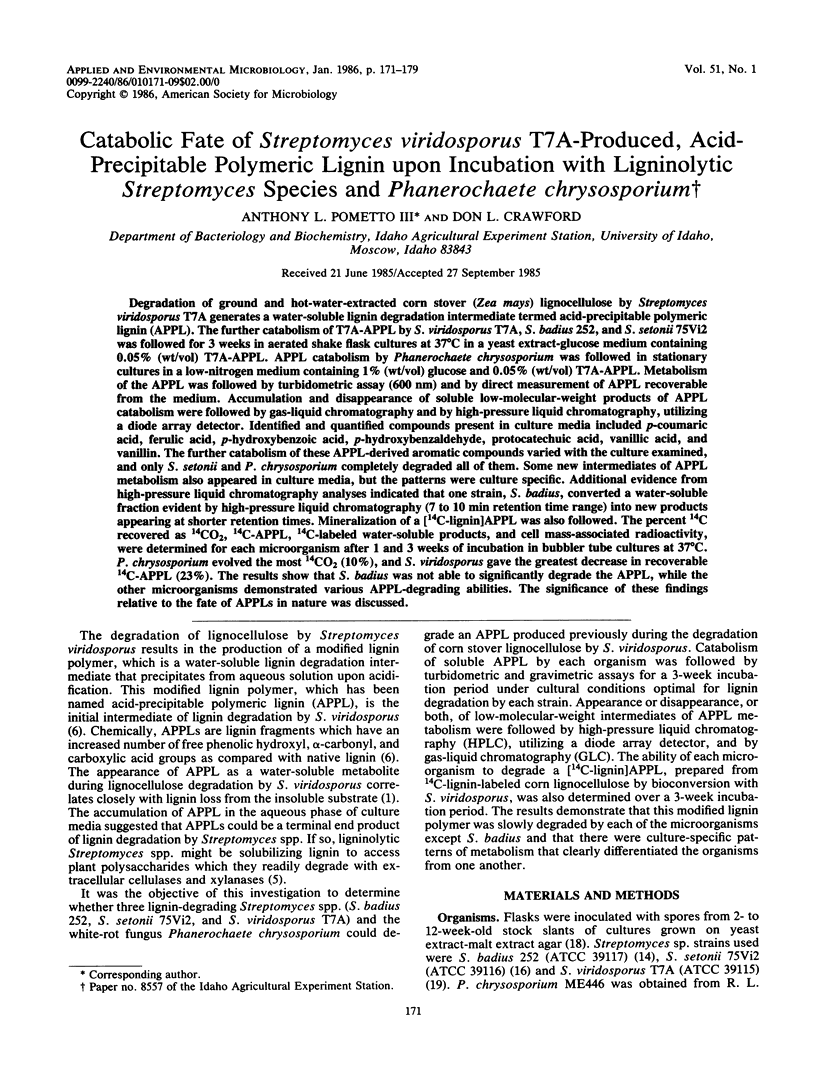
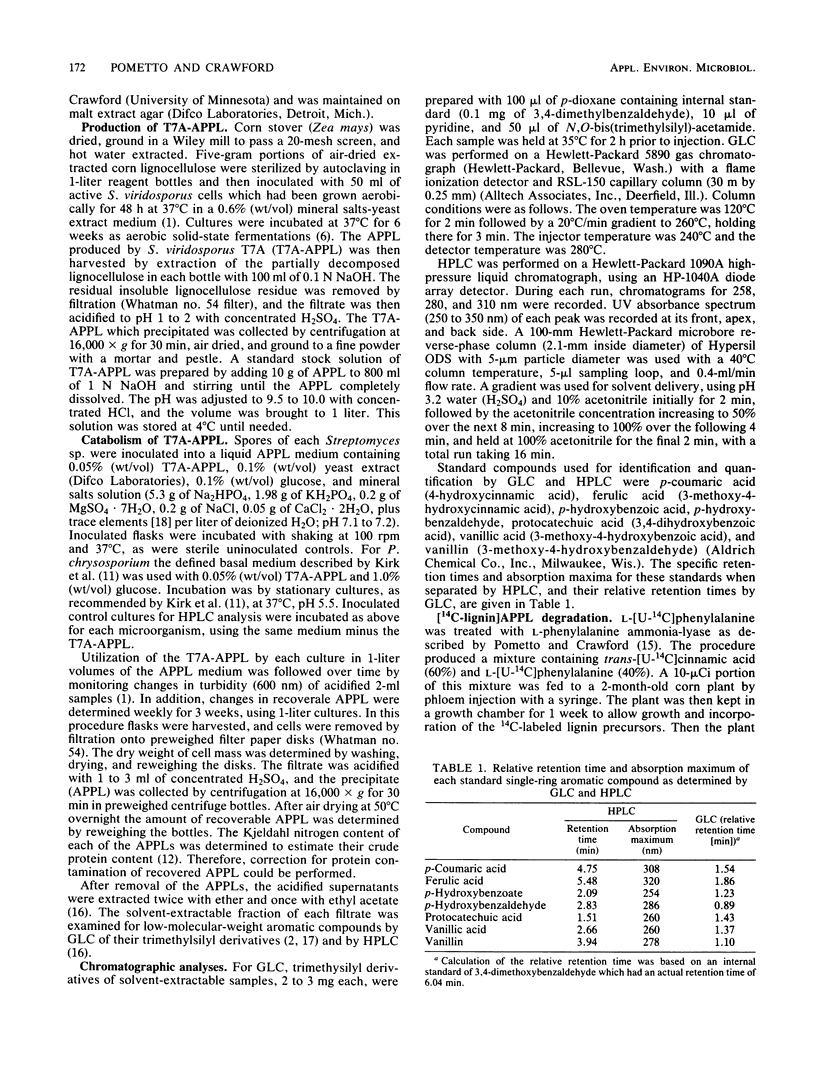
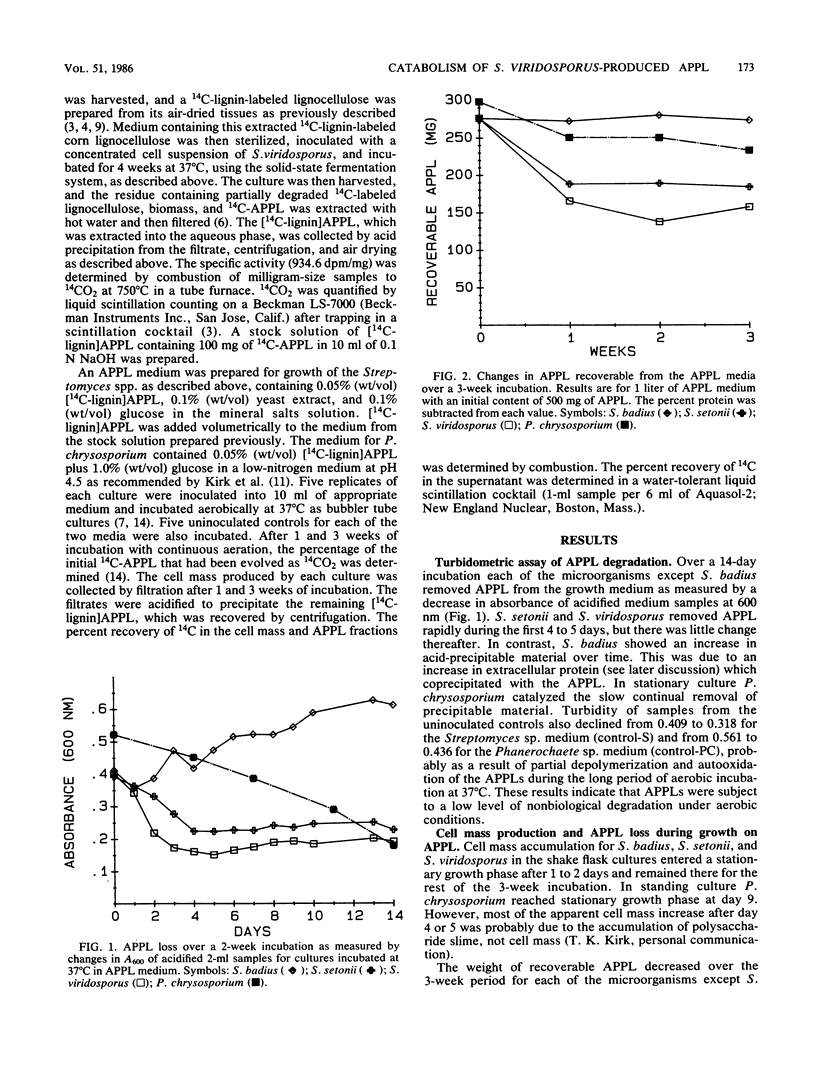
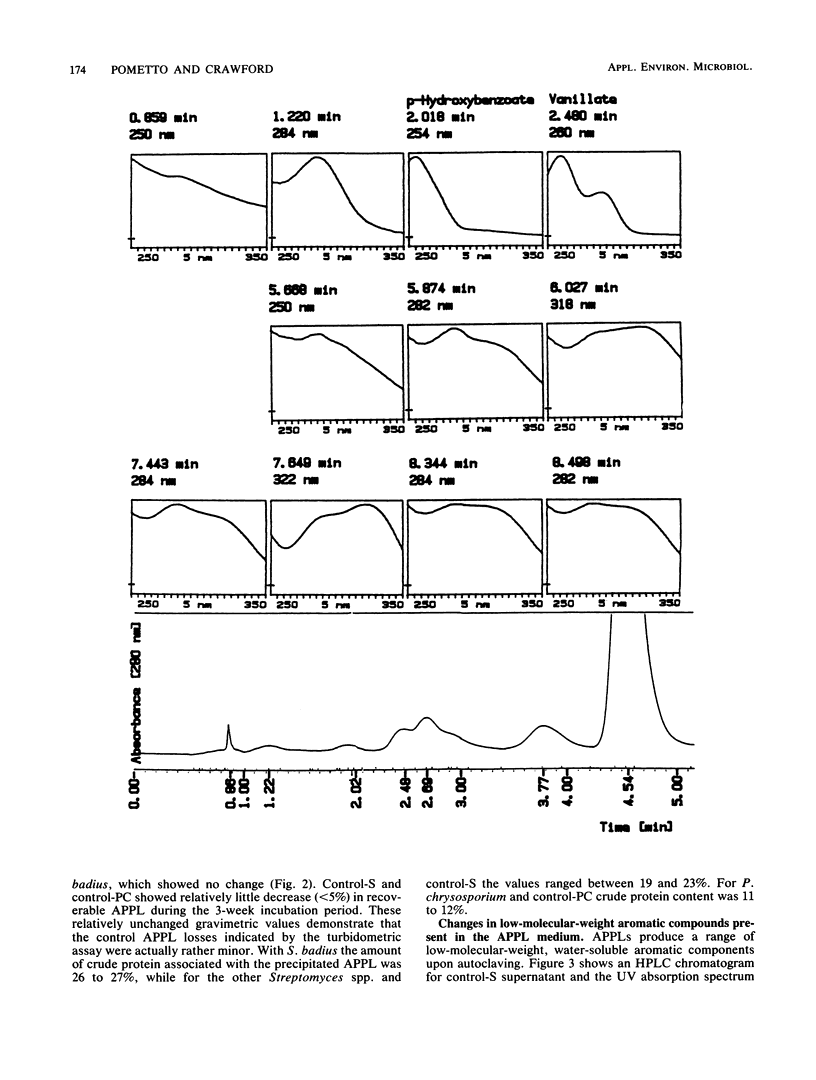
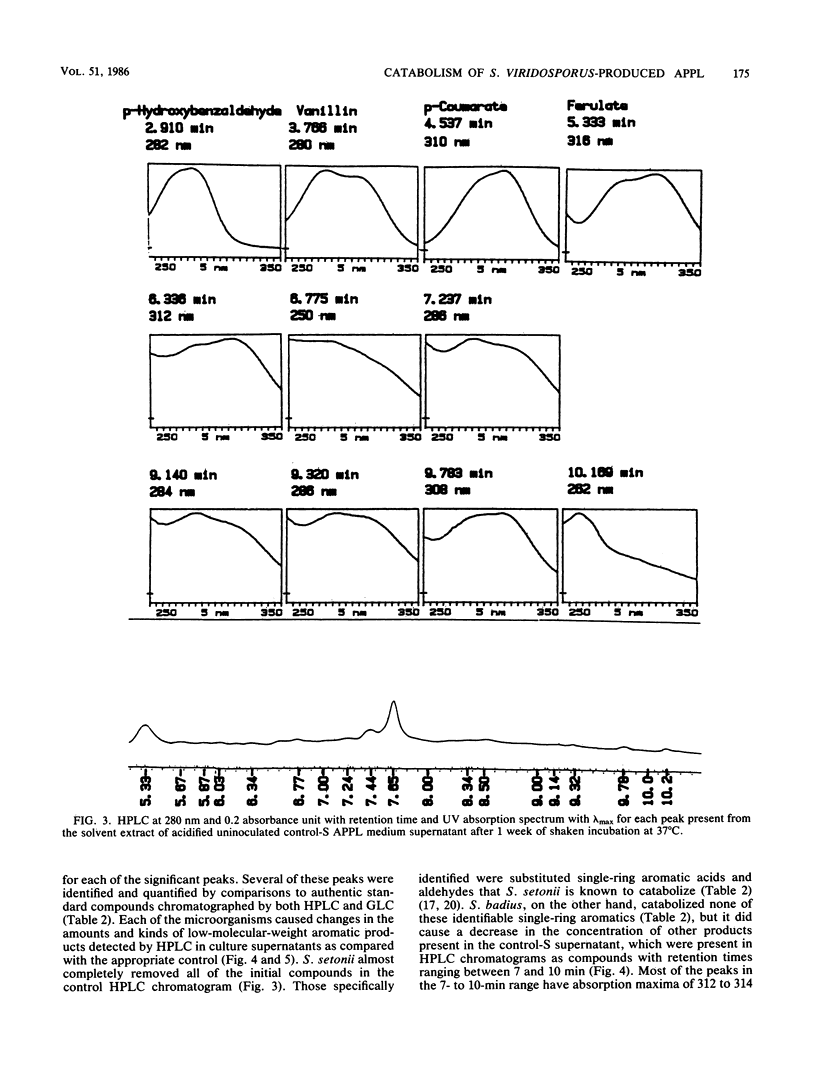

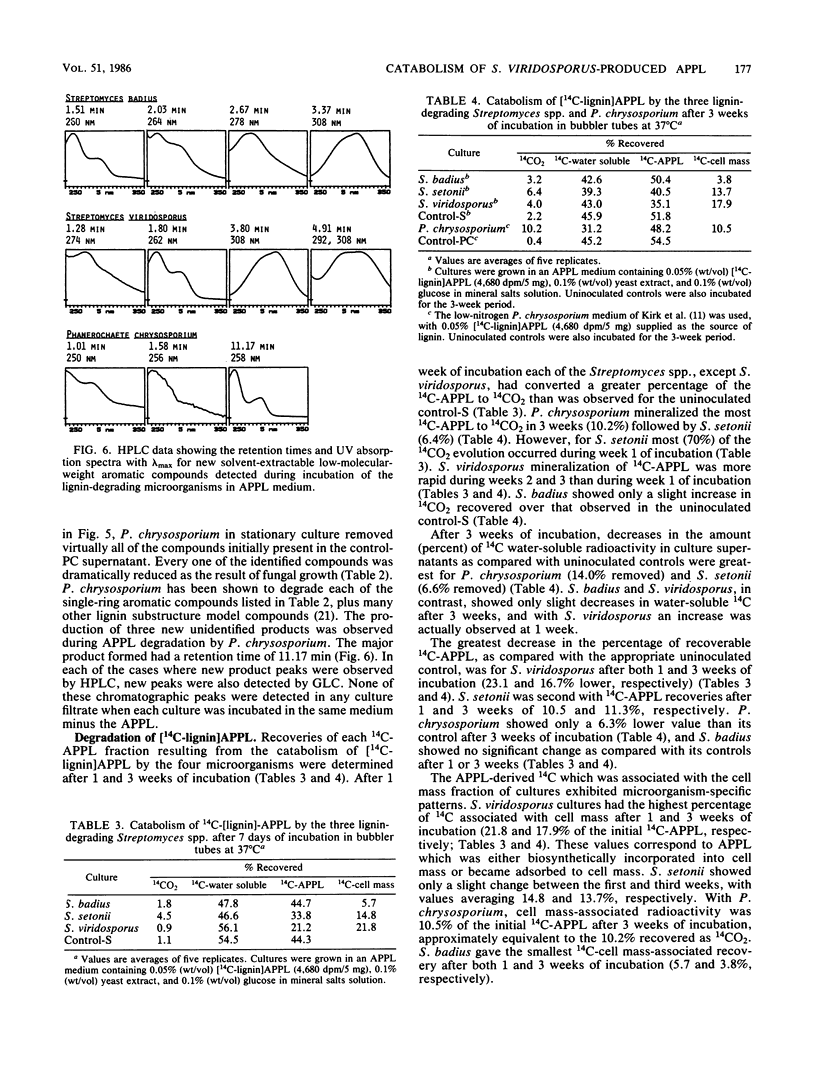


Selected References
These references are in PubMed. This may not be the complete list of references from this article.
- Borgmeyer J. R., Crawford D. L. Production and Characterization of Polymeric Lignin Degradation Intermediates from Two Different Streptomyces spp. Appl Environ Microbiol. 1985 Feb;49(2):273–278. doi: 10.1128/aem.49.2.273-278.1985. [DOI] [PMC free article] [PubMed] [Google Scholar]
- Crawford D. L., Crawford R. L. Microbial degradation of lignocellulose: the lignin component. Appl Environ Microbiol. 1976 May;31(5):714–717. doi: 10.1128/aem.31.5.714-717.1976. [DOI] [PMC free article] [PubMed] [Google Scholar]
- Crawford D. L., Crawford R. L., Pometto A. L. Preparation of specifically labeled C-(lignin)- and C-(cellulose)-lignocelluloses and their decomposition by the microflora of soil. Appl Environ Microbiol. 1977 Jun;33(6):1247–1251. doi: 10.1128/aem.33.6.1247-1251.1977. [DOI] [PMC free article] [PubMed] [Google Scholar]
- Crawford D. L., Pometto A. L., Crawford R. L. Lignin Degradation by Streptomyces viridosporus: Isolation and Characterization of a New Polymeric Lignin Degradation Intermediate. Appl Environ Microbiol. 1983 Mar;45(3):898–904. doi: 10.1128/aem.45.3.898-904.1983. [DOI] [PMC free article] [PubMed] [Google Scholar]
- Faison B. D., Kirk T. K. Factors Involved in the Regulation of a Ligninase Activity in Phanerochaete chrysosporium. Appl Environ Microbiol. 1985 Feb;49(2):299–304. doi: 10.1128/aem.49.2.299-304.1985. [DOI] [PMC free article] [PubMed] [Google Scholar]
- Phelan M. B., Crawford D. L., Pometto A. L., 3rd Isolation of lignocellulose-decomposing actinomycetes and degradation of specifically 14C-labeled lignocelluloses by six selected Streptomyces strains. Can J Microbiol. 1979 Nov;25(11):1270–1276. doi: 10.1139/m79-200. [DOI] [PubMed] [Google Scholar]
- Pometto A. L., 3rd, Crawford D. L. L-Phenylalanine and L-tyrosine catabolism by selected Streptomyces species. Appl Environ Microbiol. 1985 Mar;49(3):727–729. doi: 10.1128/aem.49.3.727-729.1985. [DOI] [PMC free article] [PubMed] [Google Scholar]
- Pometto A. L., 3rd, Sutherland J. B., Crawford D. L. Streptomyces setonii: catabolism of vanillic acid via guaiacol and catechol. Can J Microbiol. 1981 Jun;27(6):636–638. doi: 10.1139/m81-097. [DOI] [PubMed] [Google Scholar]
- Pridham T. G., Gottlieb D. The Utilization of Carbon Compounds by Some Actinomycetales as an Aid for Species Determination. J Bacteriol. 1948 Jul;56(1):107–114. doi: 10.1128/jb.56.1.107-114.1948. [DOI] [PMC free article] [PubMed] [Google Scholar]
- Sutherland J. B., Crawford D. L., Pometto A. L., 3rd Metabolism of cinnamic, p-coumaric, and ferulic acids by Streptomyces setonii. Can J Microbiol. 1983 Oct;29(10):1253–1257. doi: 10.1139/m83-195. [DOI] [PubMed] [Google Scholar]
- Sutherland J. B., Crawford D. L., Pometto A. L. Catabolism of substituted benzoic acids by streptomyces species. Appl Environ Microbiol. 1981 Feb;41(2):442–448. doi: 10.1128/aem.41.2.442-448.1981. [DOI] [PMC free article] [PubMed] [Google Scholar]


